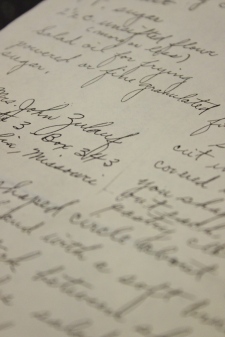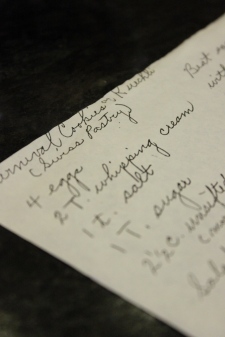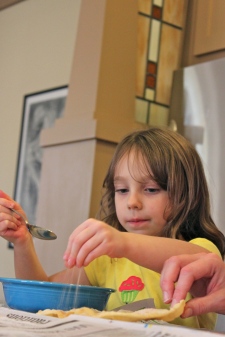
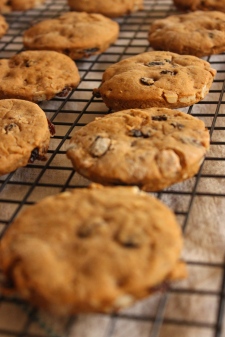
Last month marked the three-year anniversary of the passing of my grandpa (Pepaw). My sister and our families had dinner together to remember him and reflect on the wonderful life he led. A few days later in an email thanking us for continuing to share the memory of my grandfather, my grandma said “…it is so important for children to feel the support of past generations”. This struck me as a simple yet poignant idea.
I love the idea that the decisions, mistakes, lessons-learned, love affairs, careers, and laughs of the past lay the foundation of a family and offer new generations guidance, tradition, and comfort.
Food is a wonderful way to see, feel, and taste your family history. After reading my grandmother’s email and anticipating the holiday season, I recently had the urge to investigate a recipe that has been a part of my family’s Christmas tradition for many generations.
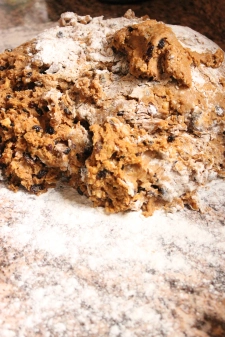

For as long as I can remember my great-great cousin Zelia (my grandmother’s first cousin) would give us a bag of Lebkuchen every Christmas while my family and I were visiting my grandparents in Missouri. I’m sorry to say, that growing up, I was never a fan of these traditional German Christmas cookies and their distinctive smell was always an unwelcome (and lingering) passenger in the car on our drive back to Texas when my dad would enjoy them for a snack. My idea of a cookie at the time only involved the words chocolate and chip and Lebkuchen (or Leb or Lep cookies), full of musky molasses, bitter black walnuts, and raisins did not fit into my close-minded view of a good cookie.
In fact, I had never seen or heard of another Leb cookie, which made me even more suspicious of them, until I was shopping at the Dutch Bakery in Tipton, Missouri. Interestingly, Tipton is the town where my Swiss family eventually settled and built a farm after immigrating to the States by way of Wisconsin. So, I decided to give them another try and they weren’t nearly as bad as I remember them being…in fact…they were quite good. As an adult, I have found the flavor of molasses to be quite a treat and raisins are no longer so terrifying.
In this December’s Food and Wine magazine, I was surprised to find a recipe for Lebkuchen and began to research other recipes as well. I was even more surprised when the majority of my internet searches led me to other mid-Missourians talking about their family’s Leb cookies. Every version seems to be different in terms of ingredients and proportions, but similar in it’s sentiment to family tradition.
It only seemed appropriate to give my family’s recipe a try. Having never actually made my family’s Leb cookies or even seen the recipe, I went right to the source, my cousin Zelia, to get the recipe and more background on these special cookies. I learned that our original Lebkuchen recipe was brought to America from the Swiss Alps by my great-great grandmother Anna Schneider and was passed from her to my great-great Aunts (Anna and Ida) and Zelia’s mother. They get better with age, wooden spoons don’t stand a chance against the hefty dough, and the recipe makes A LOT of cookies…even a half recipe.
Below is an excerpt of Zelia’s wonderfully written email to me that explains the Leb cookie and their place in our family better than I could in my own words.

“I am delighted to tell you what I know about Leb Cookies. I’m sure that Grandmother Anna Schneider Zulauf brought the basic recipe with her, but the move to Missouri from Wisconsin brought about the changes of the cookie into the one we all know. The cookies have been with me all my life (81 plus years). I first knew them at the farm southwest of Tipton, where Grandpa Zulauf brought his family, and where my father and mother went to live for a time during the depression in 1933-35. The usual baking time was in November, and the cookies lasted into the Spring. I don’t know how they managed to keep them that long, for when I make them they disappear by the first of January. I don’t think they ever made the whole recipe, but it might have been possible. Present day users make half the original recipe which begins with 1/2 gallon of molasses, 1 1/2 pounds of butter, and so on. The half recipe makes about 15 dozen 3-inch cookies.
Adjustments which Grandmother made for items found in Missouri for those not available are: molasses instead of honey, black walnuts instead of hazelnuts, cinnamon, all spice, and cloves instead of anise. If you research the lebkuchen found in Europe, you’ll find those are the ingredients used more frequently. For our family we search for sorghum molasses and the black walnuts early in the season, because they are not as common as they used to be even in Missouri.
The cookies bring many warm memories of occasions when they are being baked. An early one was the race to be first to get the cookies baked each holiday season, with either my mother or Aunt Anna or Ida telephoning to report the accomplishment when they had baked the cookies for the year. Also going to Aunt Anna and Ida’s and snooping in the pantry to see if there were any cookies still in the stone jar where they were stored. They do get better with age, and were a real treat at Eastertime. After Mother and Dad were empty nesters they froze the cookies, and when we would visit we often left with a container of the cookies.
[…]Mixing the cookies is quite a job–Howard has broken a few wooden spoons in the process of adding flour “till the nuts pop out.” I know Aunt Anna had Uncle Bill help her during her later years. There are other stories about the cookies–the year the soda was left in the cup after the cookies were set aside, the year Howard and I tried using blackstrap molasses (much to our daughters’ distress), and your grandfather John’s repeated critique ‘not enough nuts.’ Let’s just say, Christmas wouldn’t be Christmas without Leb Cookies made by ‘THE RECIPE.'”
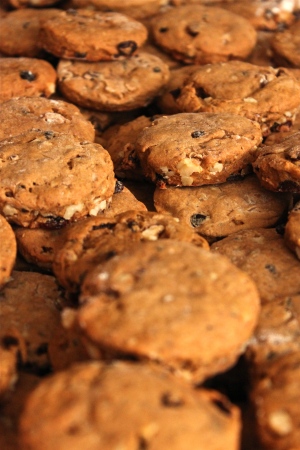
I am so grateful to Zelia for sharing this piece of our family history with me and I am thankful for the generations past for passing along recipes, stories, and the support I will always feel when I eat this cookies.
Missouri Leb Cookies
Recipe courtesy of Zelia Bell (adapted and scaled down from the original recipe from Anna Schneider, Anna Zulauf, and Ida Zulauf)
Makes about 15 dozen cookies
Note: My cousin Zelia recommends using sorghum molasses and black walnuts if you can find them. I used regular walnuts which produces a milder cookie – both ways are good! The recipe says to “add flour until the nuts pop out”. This means mix until a stiff dough forms and the nuts come to the surface and almost begin to become loose from the dough. My cousin says she usually omits the salt, but I am a great believer in adding salt while baking, so I kept it in my recipe.
Leb cookies are not a crumbly cookie like a traditional chocolate chip cookie – they are almost a cross between a cookie, biscuit, and cake. They stay soft even as they age.
1 quart molasses
1 pint brown sugar
1 sticks (3/4 cup) butter flavored shortening
1/3 cup water
1/2 lb raisins
1/2 lb dried currants
1 quart (2 lbs) walnuts (preferably black)
1 tablespoon each – cinnamon, cloves, and allspice
4 teaspoons salt
3 cups buttermilk
1/4 cup baking soda
Flour to make stiff dough (about 5 lbs)
Cream butter, brown sugar and molasses in a large bowl. Mix nuts, raisins, and currants with one cup of flour in a medium bowl and set aside. Mix baking soda with buttermilk. Add spices to 1 sifter flour [I took this to mean 1 cup of flour] and add along with buttermilk-soda mixture to creamed molasses mixture. Add nuts and fruit. Add flour “until nuts pop out”. Set dough in a cool place.
Roll on floured board until 1/4-inch thick and cut with a 2 1/4-inch biscuit cutter. Bake in 325-350 degrees oven for about 15 minutes.



